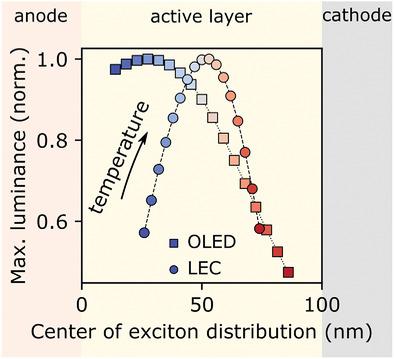当前位置:
X-MOL 学术
›
Adv. Opt. Mater.
›
论文详情
Our official English website, www.x-mol.net, welcomes your feedback! (Note: you will need to create a separate account there.)
Elucidating Deviating Temperature Behavior of Organic Light‐Emitting Diodes and Light‐Emitting Electrochemical Cells
Advanced Optical Materials ( IF 9 ) Pub Date : 2020-11-13 , DOI: 10.1002/adom.202001405 Joan Ràfols‐Ribé 1 , Eduardo Gracia‐Espino 1 , Sandra Jenatsch 2 , Petter Lundberg 1 , Andreas Sandström 3 , Shi Tang 1, 3 , Christian Larsen 1, 3 , Ludvig Edman 1, 3
Advanced Optical Materials ( IF 9 ) Pub Date : 2020-11-13 , DOI: 10.1002/adom.202001405 Joan Ràfols‐Ribé 1 , Eduardo Gracia‐Espino 1 , Sandra Jenatsch 2 , Petter Lundberg 1 , Andreas Sandström 3 , Shi Tang 1, 3 , Christian Larsen 1, 3 , Ludvig Edman 1, 3
Affiliation

|
Organic light‐emitting diodes (OLEDs) and light‐emitting electrochemical cells (LECs) exhibit different operational modes that render them attractive for complementary applications, but their dependency on the device temperature has not been systematically compared. Here, the effects of a carefully controlled device temperature on the performance of OLEDs and LECs based on two common emissive organic semiconductors are investigated. It is found that the peak luminance and current efficacy of the two OLEDs are relatively temperature independent, whereas, the corresponding LECs exhibit a significant increase by ≈85% when the temperature is changed from 20 to 80 °C. A combination of simulations and measurements reveal that this deviating behavior is consistent with a shift of the emission zone from closer to the transparent anode toward the center of the active material for both the OLEDs and the LECs, which in turn can be induced by a stronger positive temperature dependence of the mobility of the holes than the electrons.
中文翻译:

阐明有机发光二极管和发光电化学电池的温度行为偏差
有机发光二极管(OLED)和发光电化学电池(LEC)表现出不同的工作模式,这使其对互补应用具有吸引力,但尚未系统地比较它们对器件温度的依赖性。在这里,研究了基于两种常见的发光有机半导体的器件温度受到严格控制对OLED和LEC的性能的影响。发现这两个OLED的峰值亮度和电流效率是相对温度无关的,而当温度从20变为80°C时,相应的LEC则显示出≈85%的显着增加。
更新日期:2021-01-04
中文翻译:

阐明有机发光二极管和发光电化学电池的温度行为偏差
有机发光二极管(OLED)和发光电化学电池(LEC)表现出不同的工作模式,这使其对互补应用具有吸引力,但尚未系统地比较它们对器件温度的依赖性。在这里,研究了基于两种常见的发光有机半导体的器件温度受到严格控制对OLED和LEC的性能的影响。发现这两个OLED的峰值亮度和电流效率是相对温度无关的,而当温度从20变为80°C时,相应的LEC则显示出≈85%的显着增加。



























 京公网安备 11010802027423号
京公网安备 11010802027423号